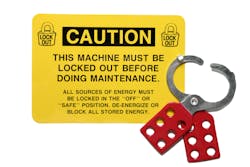Lockout/Tagout Doesn't Make Motor Work Safe
A misconception about lockout/tagout is that it renders an installation safe. But isolating energy sources is only one aspect of making a work area safe. And isolating those sources can itself be dangerous.
Consider a motor installation. What if the disconnect is improperly mounted? A common error with side lever disconnects is placing the disconnect so the person operating it must stand in front of it. The disconnect should be mounted so the operator can stand to the left of it and operate it with his left hand. This puts the operator out of any potential blast path.
What if that disconnect is not properly bonded? A person touching the body of it could receive a fatal shock.
Outdated drawings can render a lockout/tagout pointless. You may be thinking that with motors that is not an issue because the disconnect is within sight of the motor. But what other energy sources are present, and what is downstream of the motor that could present a danger when you perform rotation testing?
About the Author

Mark Lamendola
Mark is an expert in maintenance management, having racked up an impressive track record during his time working in the field. He also has extensive knowledge of, and practical expertise with, the National Electrical Code (NEC). Through his consulting business, he provides articles and training materials on electrical topics, specializing in making difficult subjects easy to understand and focusing on the practical aspects of electrical work.
Prior to starting his own business, Mark served as the Technical Editor on EC&M for six years, worked three years in nuclear maintenance, six years as a contract project engineer/project manager, three years as a systems engineer, and three years in plant maintenance management.
Mark earned an AAS degree from Rock Valley College, a BSEET from Columbia Pacific University, and an MBA from Lake Erie College. He’s also completed several related certifications over the years and even was formerly licensed as a Master Electrician. He is a Senior Member of the IEEE and past Chairman of the Kansas City Chapters of both the IEEE and the IEEE Computer Society. Mark also served as the program director for, a board member of, and webmaster of, the Midwest Chapter of the 7x24 Exchange. He has also held memberships with the following organizations: NETA, NFPA, International Association of Webmasters, and Institute of Certified Professional Managers.
